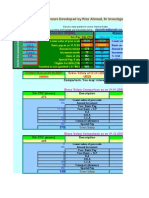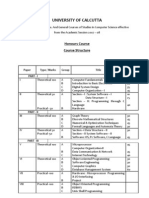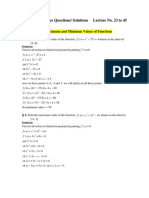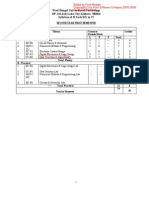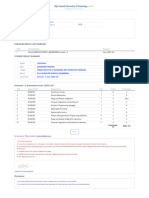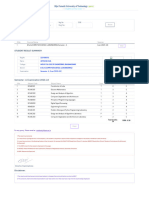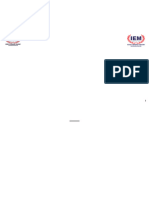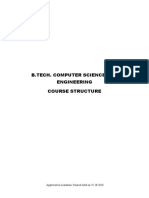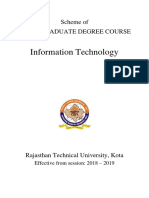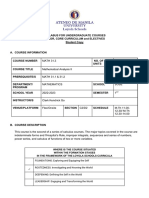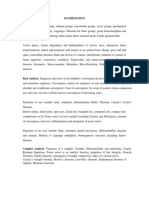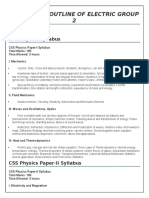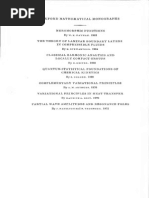BCA New Syllabus
BCA New Syllabus
Uploaded by
siddhartha rayCopyright:
Available Formats
BCA New Syllabus
BCA New Syllabus
Uploaded by
siddhartha rayCopyright
Available Formats
Share this document
Did you find this document useful?
Is this content inappropriate?
Copyright:
Available Formats
BCA New Syllabus
BCA New Syllabus
Uploaded by
siddhartha rayCopyright:
Available Formats
West Bengal University of Technology
BF-142, Salt Lake City, Kolkata-700064
Syllabus for BCA
Semester 1
Theory
Sl Course Code Topic Contact hrs/wk Credit
No L T P Total
1 BCA101 Digital Electronics 3 1 - 4 4
2 BCA102 Business Systems and Applications 3 1 - 4 4
3 BCA103 Introduction to Programming 3 1 - 4 4
4 BM101 Mathematics 3 1 - 4 4
5 BCA104 PC Software 3 1 - 4 4
Total of Theory 20 20
Practical
PC Software Lab
6 BCA194 - - 6 6 4
Programming Lab (C/ Pascal)
7 BCA193 - - 6 6 4
Total of Practical
12 8
Total
32 28
Semester 2
Theory
Sl Course Code Topic Contact hrs/wk Credit
No L T P Total
1 BCA201 Computer Architecture and Systems Software 3 1 - 4 4
2 BCA202 Information Systems Analysis & Design 3 1 - 4 4
3 BCA203 Computer Programming 3 1 - 4 4
4 BM201 Mathematics 3 1 - 4 4
5 HU201 English Language and Communication 3 1 - 4 4
Total of Theory 20 20
Practical
Programming Lab (Visual Basic)
6 BCA293 - - 6 6 4
Business Presentation and Language Lab
7 HU 291 - - 6 6 4
Total of Practical
12 8
Total
32 28
Semester 3
Theory
Sl Course Code Topic Contact hrs/wk Credit
No L T P Total
1 BCA301 Operating Systems 3 1 - 4 4
2 BCA302 Data Structures with C 3 1 - 4 4
Graphics & Internet
3 BCA303 3 1 - 4 4
4 BM301 Mathematics for Computing 3 1 - 4 4
5 BBA301 Management & Accounting 3 1 - 4 4
Total of Theory 20 20
Practical
Internet & Computer Graphics Lab
6 BCA393 - - 6 6 4
Programming Lab (Data Structure with C)
7 BCA392 - - 6 6 4
West Bengal University of Technolog BCA Syllabus 1
West Bengal University of Technology
BF-142, Salt Lake City, Kolkata-700064
Syllabus for BCA
Total of Practical
12 8
Total
32 28
Semester 4
Theory
Sl Course Code Topic Contact hrs/wk Credit
No L T P Total
1 BCA401 Data Base Management System 3 1 - 4 4
Object-Oriented Programming with C++
2 BCA402 3 1 - 4 4
Software Project Management and Quality Assurance
3 BCA403 3 1 - 4 4
4 BM401 Statistics, Numerical Methods & Algorithms 3 1 - 4 4
5 HU401 Environment and Ecology 3 - - 3 3
Total of Theory 19 19
Practical
Database Lab (Oracle)
6 BCA491 - - 6 6 4
Computing Lab
7 BM491 - - 6 6 4
Total of Practical
12 8
31 27
Semester 5
Theory
Sl Course Code Topic Contact hrs/wk Credit
No L T P Total
Data Communication & Computer Networks
1 BCA501 3 1 - 4 4
Unix and Shell Programming
2 BCA502 3 1 - 4 4
Windows Programming
3 BCA503 3 1 - 4 4
4 BCA Elective 1 3 1 - 4 4
E501/A/B/C
5 HU501 Values and Ethics of Profession 3 - - 3 3
Total of Theory 19 19
Practical
Unix & Networking
6 BCA591 - - 4 4 3
Minor Project
7 BCA592 - - 9 9 6
Total of Practical
13 9
Sessionals
Industrial Training
8 BCA 593 - - 3
Total
32 31
6 to 8 weeks Industrial Training
Semester 6
Theory
Sl Course Code Topic Contact hrs/wk Credit
No L T P Total
Elective 2
1 BCA 3 1 - 4 4
E601/A/B/C
Elective 3
2 BCA 3 1 - 4 4
E602/A/B/C
West Bengal University of Technolog BCA Syllabus 2
West Bengal University of Technology
BF-142, Salt Lake City, Kolkata-700064
Syllabus for BCA
Total of Theory 8 8
Sessionals
Major project
3 BCA693 - - 21 21 16
Seminar
4 BCA694 - - 3 2
Comprehensive Viva-Voce
5 BCA 695 - - 4
Total of Sessionals
24 22
Total
32 30
Electives for semesters 5 and 6
Elective No. Elective Code Course Code Topic
1. BCA E501 BCA E501A Advanced Unix and Shell Programming
BCA E501B Human Computer Interaction
BCA E501C Multimedia & E-Commerce
2. BCA E601 BCA E601A Advanced networking and Communication
BCA E601B Intelligent Systems
BCA E601C Image Processing
3. BCA E602 BCA E602A Software Engineering
BCA E602B Object Oriented Programming with Java
BCA E602C Advanced Database Management
Summary
Semester No Contact hr/wk Credit
1 32 28
2 32 28
3 32 28
4 31 27
5 32 31
6 32 30
Total 172
Semester duration: 15 weeks
Each lesson will consist of: 3 hours Lectures + 1 hour tutorial per week
Total lab: 12 hours per week
Detailed Syllabus
Digital Electronics
Code: BCA101
CONTACTS: 3L + 1 T
CREDITS: 4
Data and number representation- binary-complement representation BCD-ASCII, conversion of numbers form one system to the other, 2’s
complement representation, binary arithmetic
Logic gates, basic logic operations, truth tables, Boolean expression, simplification
Combination circuits, adders, Multiplexer, Sequential circuits, flip-flops, Registers, counter(Async &Sync)
Memory circuits, ROM, PROM, EPROM and dynamic RAM, Digital Components
Books:
1.Fundamentals of Digital Circuits, Anand Kumar,PHI
2Digital Electronics, Tokheim, TMH
3 Digital Electronics, S. Rangnekar, ISTE/EXCEL
West Bengal University of Technolog BCA Syllabus 3
West Bengal University of Technology
BF-142, Salt Lake City, Kolkata-700064
Syllabus for BCA
4Digital Technology:Principles & Practice,Virendra Kumar,New Age International
5Digital Circuit & Design, Salivahan,VIKAS
6Electronic Circuits, Poornachandra,SCITECH
Business Systems and Applications
Code: BCA102
CONTACTS: 3L + 1 T
CREDITS: 4
Use of computers for managerial applications, Technology issues and data processing in organisations, Introduction to Information Systems,
shift in Information system thinking, latest trends in Information Technology
Computer Based Information Systems- office automation systems. Decision making and MIS, transaction processing systems.
Decision support system, Group Decision Support, Executive Information systems, DSS generator
Introduction to:
Artificial Intelligence Based Systems, End user computing, Distributed data processing.
Deciding on IS architecture, IT leadership & IS strategic planning.
Introduction to:
IS strategy and effects of IT on competition.
Introduction to:
ERP, re-engineering work processes for IT applications, Business Process Redesign
Knowledge engineering and data warehouse.
Books:
1.Management Information System, O’Brien, TMH
2. Management Information System: A Concise Study,Kelkar,PHI
3.Decision support Systems, Janaki Raman, PHI
4 Business Information Systems, Munish Kumar, VIKAS
5.Business Application of Computers, M.M. Oka, EPH
Introduction To Programming
Code: BCA 103
CONTACTS: 3L + 1 T
CREDITS: 4
Problem analysis, need for programmed languages, introduction to algorithms, algorithmic representations, Pseudocodes flow charts and
decision tables, structured programming and modular programming .
Over view of c.
Constant, variables, data, types and size, variable declaration, operators and expressions, type conversion, conditional expression, special
operators, precedence rules. Decision making, looping and control structures. Function, recursion, arrays, pointers, structures and unions,
Managing input/output operations, formatted I/O, standard library/user-defined functions, file management in C.
Handling of character strings, Dynamic memory allocations, linked list, Pre-processor. Developing different C Programs.
Books:
1.Programming With C, Gottfried, TMH
2.The C Answer Book,Tondo,PHI
3.Programming & Problem Solving Through C Language, EXCEL BOOKS
4.Practical C Programming,Oualline,SPD/O’REILLY
5.A First Course in Pragramming with C, Jeyapoovan, VIKAS
West Bengal University of Technolog BCA Syllabus 4
West Bengal University of Technology
BF-142, Salt Lake City, Kolkata-700064
Syllabus for BCA
6.C Programming made easy, Raja Ram, SCITECH
7.Projects Using C,Varalaxmi, SCITECH
Mathematics
Code: BM 101
CONTACTS: 3L + 1 T
CREDITS: 4
Algebra: Sets, Union, intersection, complement, mapping, notion of group, ring, field with simple examples; Polynomials, division algorithm,
fundamental theorem of classical algebra (without proof), Descartes rule of sign and their application, relation between roots and coefficients,
symmetric function of roots, transformation of polynomial equations, Cardan’s solution of cubic equation.
Matrices, addition and multiplication of matrices, inverse matrix, solution of linear equations in three variables by Cramer’s rule, solution of
three line linear equations by matrix inversion method.
Differential calculus: Limits of function and continuity, fundamental properties of continuous functions (without proof), geometric meaning of
derivative and differential, rules of differentiation, successive differentiation, Rolle’s theorem, mean value theorem, Taylor’s and Maclaurin’s
theorems with Cauchy’s and Lagrange’s forms of reminder, Taylor’s series, function of several variables, partial derivatives, total differential,
Euler’s theorem on homogeneous functions of two variables.
Introduction to:
Application to plane curves.
Integral calculus: Rules of integration of indefinite integrals, solution of definite integrals and their elementary properties, idea of improper
integrals.
Dimensional geometry: Transformation of rectangular axes, invariants, general equation of second degree – reduction to standard forms and
classification, plane polar equation of a straight line, circle and conic.
Books:
1.Engineering Mathematics, Vol:1 & Vol:2, Sastry,PHI
2.University Algebra through 600 Solved Problems, N. S. Gopalakrishnan, New Age International
3.Engineering Mathematics, Arumugam, SCITECH
PC Software
Code: BCA 104
CONTACTS: 3L + 1 T
CREDITS: 4
Introduction MS Windows(Windows ’98 Second Edition)
Desktop, creation of folders and shortcuts, features of Windows explorer
Familiarisation and using MS packages – Word, Excel, PowerPoint, basic skills in using these tools.(Version MS-Office’2000)
Books:
1.Introduction to Computers with MS-Office, Leon, TMH
2.Personal Computer Software, EXCEL BOOKS
3.A First Course in Computers 2003, Saxena, VIKAS
4.Computer Concepts & Windows,Stoline,SPD/LABYRINTH
5.Windows’98 in easy steps,Harshad Kotecha, Wiley Dreamtech
6.Office 2000 in easy steps, Stephen Copestake, Wiley Dreamtech
7.Windows & MS-Office 2000, Krishnan, SCITECH
8.Trouble Shooting Microsoft Windows,PHI/MSP
West Bengal University of Technolog BCA Syllabus 5
West Bengal University of Technology
BF-142, Salt Lake City, Kolkata-700064
Syllabus for BCA
Computer Architecture and Systems Software
Code: BCA201
CONTACTS: 3L + 1T
CREDITS: 4
Microprocessors (8085 features), bus structure, Data representation, Register transfer and micro-operations, Central processing unit, Pipeline
and vector processing.
Computer arithmetic, Input-output organisation, Memory organisation, CPU architecture, instruction format, addressing mode, stacks and
handling of interrupts.
Basic computer organisation and design, programming the computer with assembly language (same basic applications), Micro-programmed
control.
Books:
1.Computer Organization, Hamacher, TMH
2.0000 to 8085 : Introduction to Microprocessors for Engineers & Scientists,Ghosh & Sridhar,PHI
3.Computer Organization & System Software, EXCEL BOOKS
4.System Architecture, Burd, VIKAS
Information Systems Analysis & Design
Code: BCA 202
CONTACTS: 3L + 1 T
CREDITS: 4
Overview of System analysis and design: Development life cycle (Waterfall, Spiral, incremental models), feasibility studies, Requirements
determination, Logical design, Physical design, Program design, Risk and feasibility analysis, prototyping
Information requirement analysis: Process modelling with physical and logical data flow diagrams, Data modelling with entity relationship
diagrams, Normalization upto 3NF
System design: Process descriptions, Input/output controls, object modelling, Database design, User Interface design, Documentation, Data
Dictionary, Development methodologies: Top down, bottom up, structured chart, decision table, decision tree, CASE productivity tools.
Testing – Unit, integration, system, Acceptance, regression, Test Case generation
Case studies.
Books:
1.System Analysis & Design, Parthasarathi, EPH
2. Analysis & Design of Information Systems,Rajaraman,PHI
3.Analysis & Design of Information Systems, Senn , MH
4.Information Systems: Analysis and Design,Ram Bansal ‘Vigyacharya’,New Age International.
5.System Analysis, Design & MIS, EXCEL BOOKS
6.Analysis, Design & Implementation of Information System, Sharma, VIKAS
7.System Analysis & Design, V.K. Jain, Wiley Dreamtech
Computer Programming
Code: BCA 203
CONTACTS: 3L + 1 T
CREDITS: 4
Introduction to visual Basic, polymorphism, inheritance, class, object etc. Creating standard exe file. Forms, Tool Bar, different Tools (Text
Box, label, combo box, list box, timer, Picture, image, command button). Code window. Basic event based programming on controls.
Including multiple forms within a project. Saving forms and projects. Using data control for database oriented application (Back end Ms-
Access).
Arrays – Single dimensional, two dimensional, dynamic
Searching – Linear and binary, sorting-bubble sort, selection sort, insertion sort; Function and sub-routine-defining a function, referencing a
function; defining a subroutine, referencing a subroutine; string processing-string function, concatenation, alphabetical sorting; Data files-
sequential data file, random access files.
Books:
West Bengal University of Technolog BCA Syllabus 6
West Bengal University of Technology
BF-142, Salt Lake City, Kolkata-700064
Syllabus for BCA
1.Programming with Visual Basic 6.0, Bradley, TMH
2.Programming & Problem Solving Through Visual Basic, EXCEL BOOKS
3.Beginning VB 6,Wright,SPD/WROX
4. Programming with Visual Basic 6.0, Azam, VIKAS
5.Visual Basic 6.0 programming,Eric A. Smith, Wiley Dreamtech
6.Visual Basic 6.0 in 60 days,Krishnan,Scitech
Mathematics
Code: BM201
CONTACTS: 3L + 1 T
CREDITS: 4
Differential equations: order, degree, solution and formation of a differential equation, standard techniques of solving a linear differential
equation with constant coefficients, Cauchy’s and Lagrange’s linear differential equations with variable coefficients.
Linear algebra: Vector space, subspaces, bases and dimensions, co-ordinates, linear transformation, algebra of linear transformations,
isomorphism, representation of transformation by matrices. Sequence and series: Bounded and unbounded sequences, convergence or
divergence of a sequence, behaviour of monotone sequences, algebrea of convergent sequences, Cauchy’s sequence, Cauchy’s general
principle of convergence, infinite series – its convergence and sum, series with positive terms and standard tests of convergence (without
proof), alternating series, Leibnitz test, absolute convergence, rearrangement of absolutely convergent series, test of convergence of Abel and
Dirichlet (without proof).
Books:
1. Engineering Mathematics,Vol:1 & 2, Sastry,PHI
2.Engineering Mathematics,Arumugam,Scitech
3.Higher Engineering Mathematics, Vol.2 , Rathore, EPH
English Language and Communication
Code: HU201
CONTACTS: 3L + 1 T
CREDITS: 4
This should cover general and technical writing, oral communications and listening skills: letter writing, technical report writing, and business
communication.
Expression: Practical communication skill development, business presentation with multimedia, speaking skill, prepared speech, extempore
speech
Reading skill: comprehension test
Writing skill: precise, technical/business letter, organisation of writing material, poster presentation, writing technical document, preparing
software user manual, necessary part required to prepare a project documentation
Details in business communication – Introduction, Meaning of communication, Role of communication in Business, Basic elements of the
communication process, level of communication, forms, models and media of communication,verbal and non-verbal communication –
functions and types. Barriers of effective communication.
Books:
1.Business Correspondence & Report Writing, Sharma, TMH
2.English for Technical communication, Laxminarayanan, Scitech
3.Business Communication,Kaul,PHI
4.Effective Technical English,Laxminarayanan,scitech
5.Communication Skill, Ghanekar, EPH
6.Communication Skill, L.M. Shakh, EPH
Operating Systems
Code: BCA301
CONTACTS: 3L + 1 T
CREDITS: 4
Importance of OS, Basic concepts and terminology, types of OS, different views, journey of a command execution, design and implementation
of OS
West Bengal University of Technolog BCA Syllabus 7
West Bengal University of Technology
BF-142, Salt Lake City, Kolkata-700064
Syllabus for BCA
Process: Concept and views, OS view of processes, OS services for process management, scheduling algorithms, performance evaluation; Inter
process communication and synchronisation, mutual exclusion, semaphores, hardware support for mutual exclusion, queuing implementation
of semaphores, classical problem of concurrent programming, critical region and conditional critical region, monitors, messages, deadlocks.
Resource manager, Memory management, file management, processor management, device management
Security and protection, authentication, protection and access control, formal models of protection, worms and viruses.
Multiprocessor system, classification and types, OS functions and requirements, Introduction to parallel computing, multiprocessor
interconnection synchronisation.
Distributes OS - rationales, algorithms for distributed processing..
Introduction to Unix OS/DOS (case study)
Books:
1. Operating Systems, Galvin, John Wiley
2.Operating Systems , Milankovic, TMH
3.An Introduction to Operating System, Bhatt,PHI
4.Modern Operating System, Tannenbaum,PHI
5.Guide to Operating Systems, Palmer, VIKAS
6.Operating Systems,Prasad,Scitech
Data Structures with C
Code: BCA 302
CONTACTS: 3L + 1 T
CREDITS: 4
Basic concepts of data representation: abstract and system defined types, primitive data structures
Linear data structures and their sequential representation: array, stack, queue, circular queue, dequeue and their operations and applications
Linear data structures and their linked representation: linear link lists, doubly linked lists, linked stack, linked queue and their operations and
applications.
Non Linear Data Structures I: Binary trees, binary search trees, representations and operations, thread representations, sequential
representations, graphs and their representation.
Searching Techniques- Linear, Binary, Interpolation
Sorting Techniques-Insertion Sort, Bubble, Selection, Quick
Non Linear Data Structures II : Hashing, Files
Programming with Data Structures in C
Books:
1.Data Structures in C, Ajay Agarwal, Cyber Tech
2.Data Structures Using C, Radhakrishnan & Shrinivasan, ISTE/EXCEL BOOKS
3. C and Data Structure,Radhaganesan,Scitech
4.Data Structure Using C & C++, Tannenbaum, PHI
5.Mastering Algorithms with C,Loudon,SPD/O’REILLY
Graphics & Internet
Code: BCA 303
CONTACTS: 3L + 1 T
CREDITS: 4
Computer graphics - Co-ordinate systems, Homogenous co-ordinate systems, line drawing algorithms, circle drawing algorithms, Two-
dimension transformations (rotation, scaling, sharing etc).
Raster scanning, CRT (Interface Design)
Clipping Algorithm (Sudderland-cohen line clipping Algorithm), Projection (Two-dimensional), Bazier, B-spline curves, shadowing.
TCP/IP, addressing in Internet – IP and domains, Servers, type of Connectivity.
Email services and protocols (X400, SMTP, UUCD, PPP, POP), FTP.
Web publishing - HTTP, browsers (naming), Introduction to HTML, Java script, use of Java applets within HTML files, ASP (Cookies and
database connectivity only).
Internet security, Introduction to e-commerce, electronic payment standards and methods.
Books:
1.Procedural & Mathematical Elements in Computer Graphics, Rogers, TMH
2.Computer Graphics, Hearn & Baker,PHI
West Bengal University of Technolog BCA Syllabus 8
West Bengal University of Technology
BF-142, Salt Lake City, Kolkata-700064
Syllabus for BCA
3.Computer Graphics, EXCEL BOOKS
4.Introduction to Computer Graphics, A. Mukherjee, VIKAS
5.Fundamentals of Computer Graphics & Multimedia, Mukherjee,PHI
6.Beginning ASP 3.0, Baser,SPD/WROX
7.Dynamic HTML,Goodman,SPD/O’REILLY
8.HTML Black Book , Stephen Holzner, Wiley Dreamtech
9.ASP 3.0 programming Bible,Eric A. Smith, Wiley Dreamtech
10.Computer Graphics, Bhandari & Joshi, EPH
Mathematics for Computing
Code: BM301
CONTACTS: 3L + 1 T
CREDITS: 4
Propositional logic, Logical equivalence
Permutation and combinations
Generating functions, Recurrence relations
Graph Theory Concepts Graphs, sub-graphs, cyclic graphs
Trees, spanning trees, binary trees, Algorithms- Prim’s, Kruskal
Isomorphism, homomorphism
Finite automata – NFA, DFA, Conversion, Mealy M/C, Moore M/C ,
Introduction to Languages & Grammars and their relation with Automata.
Books:
1.Discrete Mathematics, Mott, Kandel & Baker, PHI
2.Graph Theory, N. Deo,PHI
3. Discrete Mathematical Structure, C.L. Liu, TMH
4. Discrete Mathematical Structure, Somasundaram,PHI
5.Discrete Mathematical Structure,G.S.Rao,New Age International
6.Discrete Mathematics with Applications, Rosen, TMH
7.Discrete Mathematical Structure, Dubey, EXCEL BOOKS
8. Discrete Mathematics, Iyengar, VIKAS
9. Discrete Structures and Graph Theory, Rao, Scitech
10.Mathematical Foundations, Vijayarangan, Scitech
11.Discrete Structures and Graph Theory, Rathor,EPH.
Management & Accounting
Code: BBA 301
CONTACTS: 3L + 1 T
CREDITS: 4
Basics of management; Planning, scheduling, organising, staffing, directing, controlling
Managerial economics and financial management, productivity management
Financial accounting, financial statements and analysis
Conceptual framework of cost accounting
Cost-volume profit relationship, budgeting, cost accumulation system, variable and absorption costing system
Financial accounting computer packages
Financial Management-Finance functions in Business. Relation of finance with other functions.
Source of finance long term and short term. Financial institution – IDBI, ICICI, IFCI and Commercial Banks.
Conceptual framework of Cost-Accounting- Basic cost concept. Cost determination process, costing for materials, labour and overheads.
Profitability Analysis – budgeting – application of Capital budgeting techniques for decision making.
Books:
1.Management Accounting,M.E.Thukaram Rao,New Age International
2.Management Accounting, Khan & Jain, TMH
3.Cost Accounting-An Introduction, Nigam & Jain, PHI
4.Management Accounting, Pande, VIKAS
5.Accounting and Financial Management for MCA & MBA students,SCITECH
6. Management Accounting, A.P.Rao. EPH.
7. Cost & Management Accounting ,Inamdar.EPH.
West Bengal University of Technolog BCA Syllabus 9
West Bengal University of Technology
BF-142, Salt Lake City, Kolkata-700064
Syllabus for BCA
Data Base Management System
Code: BCA 401
CONTACTS: 3L + 1 T
CREDITS: 4
Introduction to DBMS, architecture, administration roles, data dictionary
Traditional models, three-level architecture, hierarchical model, network model and relational model, File organization , Security.
Relational model – definitions and properties, keys , integrity rules, relational algebra, joins, set operations, Tuple relational calculus
SQL constructs, embedded SQL , Query & Query Optimisation Techniques.
Database design, conceptual, logical and physical models, ER diagram and model,
Functional Dependency ( Armstrong’s Axioms), Normal forms( 1NF, 2NF, 3NF, BCNF)
Indexing- Primary, Secondary, Multilevel
Books:
1.Data Base System Concepts, Korth, TMH
2.Fundamentals of DBMS,Vig & Walia, ISTE/EXCEL
3. Data Base Management System, A.K. Pujari, ISTE/EXCEL
4. Data Base Management System, Leon, VIKAS
5.Data Base Concepts, Kroenke,PHI
6.Oracle PL/SQL Programming, Feuerstein, SPD/O’REILLY
7. Data Base Management System, V.K. Jain, Wiley Dreamtech
8.SQL PL/SQL for Oracle 8 & 8i,P.S. Deshpande, Wiley Dreamtech
Object-Oriented Programming with C++
Code: BCA 402
CONTACTS: 3L + 1 T
CREDITS: 4
Basics of Object Oriented programming and software design
C++ object-oriented programming
C++ & ANSI standard C, Predefined classes in C++
Building objects with classes, Introduction to Constructor, Destructor, Defining operations on objects, Using Inheritance in C++, Concepts of
Overloading ,Virtual functions and Polymorphism
Using C libraries in C++ programs, Using commercial class libraries (Standard template library)
Advanced Topics in C++ ( Templates, Exception Handling, file handling, Streams)
Books:
1.Object Oriented Programming and C++, Balaguruswamy, TMH
2.Programming in C++, Shah & Thakker, ISTE/EXCEL
3.C++ Programming Today,Johnston,PHI
4.Revolutionary Guide to Object Oriented Programming Using C++,Olshevsky,SPD/WROX
5.Object Oriented Programming and C++, R.Rajaram, New Age International
6. Object Oriented Programming with C++ & JAVA,Samanta,PHI
7. Object-Oriented Programming with C++, Subburaj, VIKAS
8. Object-Oriented Programming with C++, Emmerel , Wiley Dreamtech
9.Programming with C++,Radhaganesan,Scitech
West Bengal University of Technolog BCA Syllabus 10
West Bengal University of Technology
BF-142, Salt Lake City, Kolkata-700064
Syllabus for BCA
Software Project Management and Quality Assurance
Code: BCA 403
CONTACTS: 3L + 1 T
CREDITS: 4
Project management concepts
People, process, project and product (4P)
Planning software. Projects – project schedule, PERT, Gantt Charts, S/W project plan document.
System development life cycle.
Project teams, project monitoring and controls- Formal Technical Review (FTR),Cost estimation, COCOMO model, S/W metrics-size oriented
and functions oriented.
Using project management software tools, quality management, issue, standards and methods. ISO and CMM.
Risk management, Configuration management.
Books:
1.Software Project Management, Hughes, TMH
2.Software Project Management,Kelkar,PHI
2.Information System Project Mgmt., Schwable, VIKAS
4.Software Project Management from concept to deployment with CD, Kieron Conway, Wiley Dreamtech
Numerical Methods & Algorithms
Code: BM401
CONTACTS: 3L + 1 T
CREDITS: 4
Approximation in numerical computation, Truncation and rounding errors.
Interpolation : Lagrange’s interpolation, Newton forward and backward differences interpolation, Newton divided difference.
Numerical Integration: Trapezoidal rule, Simpson 1/3 rule, Weddle’s rule.
Numerical solution of a system of linear equation
Gauss elimination method, Matrix inversion, LU factorisation method, Gauss-Jacobi method, Gauss Seidel method.
Algebraic Equation : Bisection method, Secant method, Regula–Falsi method, Newton Raphson method, Method of Iteration
Numerical solution of ordinary differential equation : Taylor’s series method, Euler’s method, Runga – kutta method, predictor – correction
method.
Books :
1.Numerical Mathematical Analysis ,Sastry,PHI
2.Numerical Mathematical Analysis (By J.B.Scarborough)
3.Numerical Analysis & Algorithms, Pradeep Niyogi, TMH
4.Numerical Mathematical Analysis ,Mathews,PHI
5.C language and Numerical Methods ( By C.Xacier)
6.Numerical Analysis ( By S. Ali Mollah)
7.Introductory Numerical Analysis(By Dutta & Jana)
8.Numerical Methods (Problems and Solution) (By Jain , Iyengar & Jain),New Age International
9.Computer Oriented Numerical Methods, N. Dutta, VIKAS
10.Numerical Methods,Arumugam,Scitech
11.Numerical Methods in Computer Applications, P.U.Wayse.EPH.
Environment and Ecology
Code: HU401
CONTACTS: 3L
CREDITS: 3
Introduction , components of the environment, environmental degradation
Ecology: Elements of Ecology ; Ecological balance and consequences of change, principles of environmental impact assessment
Air Pollution and Control: Atmospheric composition, energy balance, climate, weather, dispersion, sources and effects of pollutants, primary
and secondary pollutants, green house effect, depletion of ozone layer, standards and control measures.
West Bengal University of Technolog BCA Syllabus 11
West Bengal University of Technology
BF-142, Salt Lake City, Kolkata-700064
Syllabus for BCA
Water Pollution and Control: Hydrosphere, natural water, pollutants: their origin and effects, river / lake / ground water pollution, standards
and control.
Land Pollution: Lithosphere, pollutants (municipal, industrial, commercial, agricultural, hazardous solid wastes); their origin and effects,
collection and disposal of solid waste, recovery and conversion methods.
Noise Pollution: Sources, effects, standards and control.
Books:
1. Environmental Science, Cunningham, TMH
2.Environmental Pollution Control Engineering,C.S.Rao,New Age International
3. Environmental Science,Wright & Nebel, PHI
4.Environmental Pollution Analysis,S.M.Khopkar,New Age International
5. Environmental Mgmt, N.K. Oberoi, EXCEL
6. Environmental Mgmt, Mukherjee, VIKAS
7. Ecosystem Principles & Sustainable Agriculture,sithambaranathan,Scitech
Data Communication & Computer Networks
Code: BCA 501
CONTACTS: 3L + 1 T
CREDITS: 4
Introduction to computer network- Topology; Base Band & Broad Band Topology;
Guided & Unguided Media.
Overview of Data & Signal Bits. Baud & Bit Rate. Modulation (AM, PM, FM);
Multiplexing (TDM, FDM, STDM).
Digital To Analog – ASK, PSK, FSK, QPSK.
Transmission methods – Synchronous & Asynchronous, Flow Control, Error Control,
Error Detection methods.
Goals of Layered protocols- Introduction to OSI, TCP/IP
HDLC- frame format, station, states, configuration, access control.
LAN Topology – Ethernet (IEEE 802.3), Token Bus (IEEE 802.4), Token Ring (IEEE 802.5)
Switching Technologies – Circuit, Message, and Packet.
X.25, X.21, RS-232 C – frame format, channel, packet frames, facilities (In brief Only).
ISDN- D channel, B-Channel, International Standards, NT1, NT2, TA, TE Devices.
Bridging & Routing – Static.
Congestion Control – Leaky Bucket & Token Bucket Algorithms.
Introduction to data security (private key, public key)
Books:
1.Data Communication & Networking, Forouzan, TMH
2. Computer Networks,Tannenbaum,PHI
3.Computer Communication Networks,Shanmugam & Rajeev, ISTE/EXCEL
4.Data Communication,Prakash C. Gupta, PHI
5. Data & network Communication, Miller, VIKAS
6. Data Communication & Network, Dr. Prasad, Wiley Dreamtech
7. Computer network Theory,Prasad,Scitech
Unix and Shell Programming
Code: BCA 502
CONTACTS: 3L + 1 T
CREDITS: 4
The UNIX Operating System
File system, General-purpose utilities
The Bourne Shell, Simple filters
West Bengal University of Technolog BCA Syllabus 12
West Bengal University of Technology
BF-142, Salt Lake City, Kolkata-700064
Syllabus for BCA
Advanced Filters – I, Advanced Filters - II
Line editing with ex, Vi editor
The Process, communication and scheduling
Programming with the Shell
Introduction to System administration.
Books:
1.UNIX-Concepts & Applications, Sumitava Das, TMH
2.Learning UNIX Operating System,Peek, SPD/O’REILLY
3.Understanding UNIX,Srirengan,PHI
4.Learning the Vi Editor,Lamb, SPD/O’REILLY
5.Essentials Systems Administration,Frisch, SPD/O’REILLY
Windows Programming
Code: BCA503
CONTACTS: 3L + 1 T
CREDITS: 4
Windows concepts and terminology, key elements, creating the look, using OO technology, communication via messages, windows resources
and functions
Writing windows applications, taking control of windows, adding menus, dialog boxes, MFC programming concepts
Values and Ethics of Profession
Code: HU501
CONTACTS: 3L
CREDITS: 3
Science, Technology and Engineering as Knowledge and as Social and Professional Activities (2 lectures)
Effects of Technological Growth: Rapid Technological growth and depletion of resources. Reports of the Club of Rome. Limits of growth;
sustainable development
( 2 lectures)
Energy Crisis; Renewable Energy Resources (2 lectures)
Environmental degradation and pollution. Eco-friendly Technologies. Environmental Regulations. Environmental Ethics
(4 lectures)
Appropriate Technology Movement of Schumacher: later developments (2 lectures)
Technology and developing nations. Problems of Technology transfer. Technology assessment, impact analysis
(4 lectures)
Human Operator in Engineering projects and industries. Problems of man machine interaction. Impact of assembly line and automation.
Human centered Technology
(4 lectures)
Ethics of Profession
Engineering profession: Ethical issues in engineering practice. Conflicts between business demands and professional ideals. Social and ethical
responsibilities of Technologists. Codes of professional ethics. Whistle blowing and beyond. Case studies. (8 lectures)
Profession and Human Values
Value Crisis in contemporary society (2 lectures)
Nature of values: Value Spectrum of a ‘good’ life (2 lectures)
Psychological values: Integrated personality; mental health (2 lectures)
Societal values: The modern search for a ‘good’ society, justice, democracy, secularism, rule of law; values in Indian Constitution
(4 lectures)
Aesthetic values: Perception and enjoyment of beauty, simplicity, clarity (2 lectures)
Moral and ethical values: Nature of moral judgments; canons of ethics; ethics of virtue; ethics of duty; ethics of responsibility
Books:
1. Ethics in Mgmt & Indian Ethos,Ghosh, VIKAS
2. Business Ethics,G.Pherwani,EPH.
3. Ethics, Indian Ethos & Mgmt, Balachandran, Raja & Nair,SHROFF Publishers
West Bengal University of Technolog BCA Syllabus 13
West Bengal University of Technology
BF-142, Salt Lake City, Kolkata-700064
Syllabus for BCA
Electives for BCA
Advanced Unix and Shell Programming
Code: BCA E501A
CONTACTS: 3L + 1 T
CREDITS: 4
Organisation of Unix. User interface, Programmer interface. The environment of Unix process System calls. Process control, File related
system calls. Process related system calls. Signals programming using system calls. Advanced I/O multiplexing. Memory mapped I/O. Inter-
process communication: Pipes, shared memory, semaphores, messages. Advanced inter-process communications. Streams, Pipes, Open server.
Books:
1.Your UNIX, The Ultimate Guide, Sumitava Das, TMH
2.Design of Unix Operating System,Bach,PHI
3.UNIX Programming Environment,Kernigham & Pike,PHI
4.Learning UNIX Operating System,Peek, SPD/O’REILLY
5.Learning the Vi Editor,Lamb, SPD/O’REILLY
6.Essentials Systems Administration,Frisch, SPD/O’REILLY
Object Oriented Programming with Java
Code: BCA E602B
CONTACTS: 3L + 1 T
CREDITS: 4
Oops Concept and Introduction to JAVA
An overview of Java
Data Types - variables and arrays
Operators, Control statements
Classes and objects, Inheritance, String and string buffer, Packages, Interfaces, Exception handling, Multithreaded Programming, Applets,
Event handling
Abstract Window Toolkit
Books:
1.JAVA 2- The Complete Reference, TMH
2.Beginning JAVA 2 SDK 1.4, Horton,SPD/WROX
3.Programming in JAVA, EXCEL
4.Object Oriented Programming With C++ & JAVA,Samanta,PHI
5.Object Oriented Application Development Using JAVA, Doke, VIKAS
6.Programming with Java 2,Xavier,Scitech
Advanced Networking and Communication
Code: BCA E601A
CONTACTS: 3L + 1 T
CREDITS: 4
Introduction to computer network- Topology; Base Band & Broad Band Topology;
Guided & Unguided Media.
Overview of Data & Signal Bits. Baud & Bit Rate. Modulation (AM, PM, FM);
Multiplexing (TDM, FDM, STDM).
Encoding (RZ, NRZ, BIPLOAR, MANCHESTER, DIFF. MANCHESTER).
West Bengal University of Technolog BCA Syllabus 14
West Bengal University of Technology
BF-142, Salt Lake City, Kolkata-700064
Syllabus for BCA
Digital To Analog – ASK, PSK, FSK, QPSK.
Transmission methods – Synchronous & Asynchronous, Flow Control, Error Control,
Error Detection methods.
Goals of Layered protocols- Introduction to OSI, TCP/IP, IBM, SNA, ATM.
Bit oriented (BSC) & Character oriented Protocol (SDLC, LAPB, LAPD, LLC)
HDLC- frame format, station, states, configuration, access control.
LAN Topology – Ethernet (IEEE 802.3), Token Bus (IEEE 802.4), Token Ring (IEEE 802.5)
Introduction to WAN – DQDB (IEEE 802.6) & FDDI.
Switching Technologies – Circuit, Message, and Packet.
X.25, X.21, RS-232 C – frame format, channel, packet frames, facilities (In brief Only).
ISDN- D channel, B-Channel, International Standards, NT1, NT2, TA, TE Devices.
Introduction to leased lines, DSL, Digital Carriers.
Bridging & Routing – Static & Dynamic (In Brief).
IP, IP addressing, ICMP, ARP.RARP.
Congestion Control, TCP, UDP.
HTTP,FTP,Telnet,SMTP.
Introduction to data security (private key, public key, ISO standards).
Introduction to Mobile technology (Topology, FDM, TDM, CDMA), Satellite Communication (LEO, GEO, TDM).
Books:
1.Data Communication & Networking, Forouzan, TMH
2.Computer networks,Tannenbaum,PHI
3.Computer Communication Networks,Shanmugam & Rajeev, ISTE/EXCEL
4.Data & Computer Communication,Stallings,PHI
5.Data & Network Communication, Miller, VIKAS
6.Data Communication & Network, Dr. Prasad, Wiley Dreamtech
7.Computer Network Theory, Prasad, Scitech
Multimedia and E-commerce
Code: BCA E501C
CONTACTS: 3L + 1 T
CREDITS: 4
Multimedia system design and development
Computer Systems in Electronic Business
Business Process Re-Engineering
Electronic commerce Policy and Theory
Supply Chain Management
Customer Relationship Management
International trading network & communication protocols
Electronic payment standards
E-Commerce strategy, Marketing and Business Processes
Books:
1.E-Commerce, P.T. Joseph, PHI
2.Multimedia Systems Design,Andleigh,PHI
3.E-Commerce Mgmt.- Text & Cases, Krishnamurthy, VIKAS
4.Multimedia & Web Create, Coorough, VIKAS
5.Streaming Multimedia Bible with CD,Steve, Wiley Dreamtech
6.E-Commerce,Oka,EPH.
7.Beginning E-Commerce,Reynolds,SPD/WROX
West Bengal University of Technolog BCA Syllabus 15
West Bengal University of Technology
BF-142, Salt Lake City, Kolkata-700064
Syllabus for BCA
Intelligent Systems
Code: BCA E601B
CONTACTS: 3L + 1 T
CREDITS: 4
Scope of Artificial Intelligence, games, theorem proving, natural language processing, vision and speech processing, robotics, expert systems,
AI techniques in search and knowledge abstraction
Problem solving; state space search, search space control, heuristic search, hill climbing, branch and bound
Knowledge representation; predicate logic, rule-based system, structured knowledge representation, semantic net
Handling uncertainty, Fuzzy sets, probabilistic reasoning
Learning, learning automation, learning by induction, Neural Networks, Genetic Algorithms
Emerging technologies and devices
Books:
1.Artificial Intelligence, Rich & Knight, TMH
2.Introduction to AI & Expert Systems,Patterson,PHI
3.Neural Networks, Fuzzy Logic & Genetic Algorithms,Rajsekharan,PHI
4.Expert Systems, Giaranto, VIKAS
Image Processing
Code: BCA E601C
CONTACTS: 3L + 1 T
CREDITS: 4
Image digital representation. Elements of visual perception. Sampling and quantisation. Image processing system elements. Fourier transforms.
Extension to 2-D, DCT, Walsh, Hadamard transforms. Enhancement and segmentation. Point and region dependent techniques. Image
encoding: Fidelity criteria. Transform compression. KL, Fourier, DCT, Spatial compression, Run length coding. Huffman and contour coding.
Restoration: Models: Constrained & Unconstrained, Inverse filtering, Least squares filtering, Recursive filtering.
Books:
1.Digital Image Processing & Analysis, Chanda, PHI
2.Fundamentals of Digital Image Processing,Jain,PHI
3.Image Processing , Analysis & Machine Vision , Sonka, VIKAS
Software Engineering
Code: BCA E602A
CONTACTS: 3L + 1 T
CREDITS: 4
Introduction of Software Engineering
Software life cycles - different models
Structured system design
User Interface Design
Data Oriented Analysis and Design
Object Oriented Analysis & Design
Software quality assurance, Software testing techniques and strategies, test planning, reporting and bug fixing
Test automation, regression testing
Software maintenance
Computer Aided Software Engineering (CASE) tool
Software Complexity & Reliability
West Bengal University of Technolog BCA Syllabus 16
West Bengal University of Technology
BF-142, Salt Lake City, Kolkata-700064
Syllabus for BCA
Software Project Management
Books:
1.Software Engineering , Rogers G. Pressman, TMH
2. Software Engineering, Ghezzi,2nd Ed, PHI
3.Software Engineering,K.K.Aggarwal & Yogesh Singh,New Age International
4.Software Engineering , Leon, VIKAS
5. Software Engineering: Principles & Practice,Vanvliet,SPD/JOHN WILEY
6.Software Testing Fundamentals:Methods & Metrices, Marnie Hutchson, Wiley Dreamtech
Human-Computer Interaction
Code: BCA E501B
CONTACTS: 3L + 1 T
CREDITS: 4
Foundations of human-computer interaction (8 hours): Human-centered development and evaluation, Human performance models,
accommodating human diversity, Principles of good design and good designers, engineering tradeoffs
Human-centered software evaluation (6 hours): Evaluation without users: walkthroughs, KLM, guidelines, and standards, Evaluation with
users: usability testing, interviews, survey, experiment
Human-centered software development (10 hours): Approaches, characteristics, and overview of process, Functionality and usability: task
analysis, interviews, surveys, Specifying interaction and presentation, Prototyping techniques and tools
Graphical user-interface design (10 hours): Choosing interaction styles and interaction techniques, HCI aspects of common widgets, HCI
aspects of screen design: layout, color, fonts, labeling, Handling human failure, Beyond simple screen design: visualization, representation,
metaphor, Multi-modal interaction: graphics, sound, and haptics, 3D interaction and virtual reality
Graphical user-interface programming (10 hours): UIMS, dialogue independence and levels of analysis, Widget classes, Event management
and user interaction, Geometry management, GUI builders and UI programming environments, Cross-platform design
HCI aspects of multimedia systems (8 hours): Categorization and architectures of information: hierarchies, hypermedia, Information retrieval
and human performance (Web search, Usability of database query languages, Graphics, Sound), HCI design of multimedia information
systems, Speech recognition and natural language processing, Information appliances and mobile computing
HCI aspects of collaboration and communication (8 hours): Groupware to support specialised tasks: document preparation, multi-player
games, Asynchronous group communication: e-mail, bulletin boards, Synchronous group communication: chat rooms, conferencing, Online
communities: MUDs/MOOs, Software characters and intelligent agents
Advanced Database Management
Code: MCA E602C
CONTACTS: 3L + 1 T
CREDITS: 4
Database Design: Multivalued dependencies, theory of normalisation-4NF, 5NF, 6NF DKNF
ANSI SQL2: DDL, DML, constraints and assertions, views, database security.
Transaction processing, concurrency control, Recovery management. Transaction model properties, lock base protocols, Two-phase locking,
Live – Lock, Time- Stamp Protocol.
Brief introduction to distributed database, temporal database and object-oriented database.
Embedded SQL & Applications.
Books:
1.Data Base System Concepts, Korth , MH
2.Data Base Management System, RamaKrishnan, MH
3.Data Base Management System, A.K. Pujari, ISTE/EXCEL
4.Data Base Management System, Leon, VIKAS
5.Data Base Management System,V.K. Jain,Wiley Dreamtech
Laboratory
PC Software Lab
Code: BCA194
CONTACTS: 3L + 1 T
CREDITS: 4
Basic skills lab
Introduction to MS Office, Windows Overview, Office features, Templates and Wizards, MS Word, Excel, PowerPoint, Outlook(Overview),
MS Access(Table, relation,queries,reports)
(Ms – Office Version 2000)
West Bengal University of Technolog BCA Syllabus 17
West Bengal University of Technology
BF-142, Salt Lake City, Kolkata-700064
Syllabus for BCA
Programming Lab C/Pascal
Code: BCA193
CONTACTS: 3L + 1 T
CREDITS: 4
Programming using C, study of various features of the language, Structured and modular programming, various data structures in applications
such as sorting, searching, string and list manipulation.
Programming Lab (Visual Basic)
Code: BCA293
CONTACTS: 3L + 1 T
CREDITS: 4
Computer programming with Visual Basic
Different constructs and applications, connecting with MS-ACCESS using data controls.
Business Presentation and Language Lab
Code: HU291
CONTACTS: 3L + 1 T
CREDITS: 4
Preparing business presentation with computers using PowerPoint, Developing structured project report with Word and Excel
Internet & Computer Graphics Lab
Code: BCA393
CONTACTS: 6P
CREDITS: 4
Developing web pages with HTML, Using ASP, Creating and experimenting with computer graphics. (with C-Language)
Programming Lab (Data Structure with C)
Code: BCA392
CONTACTS: 6P
CREDITS: 4
Solving problems related to Data structure implemented in C language.
Database Lab (Oracle)
Code: BCA491
CONTACTS: 6P
CREDITS: 4
Study of commercial DBMS package such as Oracle. Developing database application with Oracle Creation of a database, writing SQL
queries and retrieving data, PL/SQL.
Computing Lab
Code: BCA 492
CONTACTS: 6P
CREDITS: 4
1. Solving various problems related to object oriented programme with C++
2. Implement Numerical problems Using C/MAT LAB
3. Assignments on Interpolation: Newton forward &backward, Lagrange
West Bengal University of Technolog BCA Syllabus 18
West Bengal University of Technology
BF-142, Salt Lake City, Kolkata-700064
Syllabus for BCA
4. Assignments on Numerical Integration: Trapezoidal Rule, Simson’s 1 /3 Rule, Weddle’s
Rule
5. Assignments on Numerical solution of a system of linear equation: Gauss elimination,
Gasuss Jacobi, Matrix Inversion, Gauss Seidel
6. Assignments on Algebraic Equation: Bisection, Secant, Regula-falsi, Newton Raphson
7. Assignments on Ordinary Differential Equation: Taylor Series, Euler’s method, RungaKutta.
Unix & Networking
Code: BCA591
CONTACTS: 6P
CREDITS: 4
Using Unix, writing shell script, experimenting with Unix administration and programming. Network set-up and administration
Minor Project
Code: BCA 592
CONTACTS: 9 P
CREDITS: 6
Major Project
Code: BCA 692
CONTACTS: 21P
CREDITS: 16
Seminar
Code : BCA 693
Credits : 2
Comprehensive Viva-Voce
Code : BCA 695
Credits: 4
West Bengal University of Technolog BCA Syllabus 19
You might also like
- Engineering Mathematics Volume-Iiia (For 3rd Sem Cse & It) (B .K. Pal & K.das)Document660 pagesEngineering Mathematics Volume-Iiia (For 3rd Sem Cse & It) (B .K. Pal & K.das)sarbojit.dasgupta.21No ratings yet
- 6th Central Pay Commission Salary CalculatorDocument15 pages6th Central Pay Commission Salary Calculatorrakhonde100% (436)
- Calcutta University Computer Sc. SyllabusDocument28 pagesCalcutta University Computer Sc. SyllabusAyan Debnath75% (8)
- MTH101 Practice Qs Solutions Lectures 23 To 45Document27 pagesMTH101 Practice Qs Solutions Lectures 23 To 45Abdul Rafay86% (7)
- Computer Science & Engineering SyllabusDocument42 pagesComputer Science & Engineering Syllabusapi-26465547100% (2)
- The New 3D Layout for Oil & Gas Offshore Projects: How to ensure successFrom EverandThe New 3D Layout for Oil & Gas Offshore Projects: How to ensure successRating: 4.5 out of 5 stars4.5/5 (3)
- BCA New WBUT-1Document1 pageBCA New WBUT-1rajroy.studyNo ratings yet
- West Bengal University of Technology BF-142, Salt Lake City, Kolkata-700064 Syllabus For BCADocument29 pagesWest Bengal University of Technology BF-142, Salt Lake City, Kolkata-700064 Syllabus For BCAabir1986No ratings yet
- BCA New WBUT-2Document1 pageBCA New WBUT-2rajroy.studyNo ratings yet
- MCA New SyllabusDocument31 pagesMCA New Syllabusa janaNo ratings yet
- West Bengal University of Technology BF-142, Salt Lake City, Kolkata-700064 Syllabus of B.Tech/B.E in ITDocument45 pagesWest Bengal University of Technology BF-142, Salt Lake City, Kolkata-700064 Syllabus of B.Tech/B.E in ITMainak NandiNo ratings yet
- NIT Trichy PDFDocument132 pagesNIT Trichy PDFPradeep kumarNo ratings yet
- West Bengal University of Technology BF-142, Salt Lake City, Kolkata-700064 Syllabus of B.Tech/B.E in ITDocument68 pagesWest Bengal University of Technology BF-142, Salt Lake City, Kolkata-700064 Syllabus of B.Tech/B.E in ITanisha_basakNo ratings yet
- MCA (2years) Syllabus-2023-OnwardsDocument69 pagesMCA (2years) Syllabus-2023-OnwardsRecoth PaulNo ratings yet
- Syllabus For BSC in ICT (2022-23)Document5 pagesSyllabus For BSC in ICT (2022-23)it23013No ratings yet
- Course Structure For B. Tech in Information TechnologyDocument6 pagesCourse Structure For B. Tech in Information Technologyarifch2009scribdNo ratings yet
- 4th SemDocument2 pages4th Semgopabandhupradhan575No ratings yet
- BCA_2022-25Document98 pagesBCA_2022-25storytelling696No ratings yet
- Tentative BTech - CSE 4TH Sem Syllabus 2018-19Document26 pagesTentative BTech - CSE 4TH Sem Syllabus 2018-19robymecNo ratings yet
- MCA Syllabus of Heritage Institute of TechnologyDocument34 pagesMCA Syllabus of Heritage Institute of TechnologySachin AgarwalNo ratings yet
- BCA-SEP-SYBUSDocument16 pagesBCA-SEP-SYBUSrupasandhyamNo ratings yet
- JNTUA R15 77 6 BTech CSEDocument195 pagesJNTUA R15 77 6 BTech CSESuryavamsiNo ratings yet
- Tentative BTech - CSE 4TH Sem Syllabus 2018-19Document26 pagesTentative BTech - CSE 4TH Sem Syllabus 2018-19subhashis mishraNo ratings yet
- Bca 2022Document49 pagesBca 2022sarathiswain510No ratings yet
- Bca QDocument125 pagesBca QAnik ChatterjeeNo ratings yet
- Computer Science & Engineering SyllabusDocument47 pagesComputer Science & Engineering Syllabusapumondal18No ratings yet
- One View by AKTU SDC Team(1)Document2 pagesOne View by AKTU SDC Team(1)singhshubh430No ratings yet
- B Tech CSE R15 Syllabus PDFDocument169 pagesB Tech CSE R15 Syllabus PDFE V KarthikNo ratings yet
- Computer Science & Engineering SyllabusDocument53 pagesComputer Science & Engineering Syllabusdprakas1911No ratings yet
- Proposed Subject Scheme For B.Tech. (Information Technology)Document8 pagesProposed Subject Scheme For B.Tech. (Information Technology)api-26789938No ratings yet
- UEMK MCA SyllabusDocument86 pagesUEMK MCA Syllabusacharyanarayan719No ratings yet
- Bput Exams - ResultsDocument2 pagesBput Exams - ResultstapaswinistuNo ratings yet
- Mca 2 Years SyllabusDocument3 pagesMca 2 Years Syllabusmahakalshivam786No ratings yet
- 20crsfile CourseStructuresyllabusBCA2021-22Document102 pages20crsfile CourseStructuresyllabusBCA2021-22Nishul VashishthNo ratings yet
- It R15Document191 pagesIt R15purandharnNo ratings yet
- CSE 4th Year SyllabusDocument35 pagesCSE 4th Year Syllabuschandangacha3No ratings yet
- BCA Complete SyllabusDocument232 pagesBCA Complete SyllabusnihardebnathmakautNo ratings yet
- BCA-2nd-sem-Syllabus-Booklet (Document34 pagesBCA-2nd-sem-Syllabus-Booklet (madhuparna345No ratings yet
- Student Result: Aktu-One-View (Oneview - Aspx)Document2 pagesStudent Result: Aktu-One-View (Oneview - Aspx)ajay bhartiNo ratings yet
- Btech - Cse Iit MandiDocument6 pagesBtech - Cse Iit MandiIam CloudNo ratings yet
- Bachelor of Computer Applications: First Semester ExaminationDocument69 pagesBachelor of Computer Applications: First Semester ExaminationMayank JaiswalNo ratings yet
- Information Technology BE IVDocument25 pagesInformation Technology BE IVPrashant Kumar SahuNo ratings yet
- It Nba C-2Document36 pagesIt Nba C-2fopivNo ratings yet
- CSE Syllabus 2018-19Document237 pagesCSE Syllabus 2018-19Sajal KhatriNo ratings yet
- MSC DCS SOSDocument199 pagesMSC DCS SOSGokul GopalanNo ratings yet
- Cse r18Document175 pagesCse r18ADITYA REDDY MEKALANo ratings yet
- Updated 2.1.3, 4Document31 pagesUpdated 2.1.3, 4padmavathiNo ratings yet
- B.tech CSE Final Upto 4th Year SyllabusDocument79 pagesB.tech CSE Final Upto 4th Year SyllabusAkshat KumarNo ratings yet
- ICT StudyplanDocument6 pagesICT StudyplanALaa MubarakNo ratings yet
- Diploma 2nd Semester Course StructureDocument8 pagesDiploma 2nd Semester Course StructureMD AJMALNo ratings yet
- B.Tech. CP Structure-18-19Document5 pagesB.Tech. CP Structure-18-19050tk1krpcNo ratings yet
- Csvtu Syllabus Be Cse 6 SemDocument25 pagesCsvtu Syllabus Be Cse 6 SemCSE - Roshan PradhanNo ratings yet
- Scheme IT PDFDocument2 pagesScheme IT PDFShubham Pareek100% (1)
- Enterprise Interoperability: Smart Services and Business Impact of Enterprise InteroperabilityFrom EverandEnterprise Interoperability: Smart Services and Business Impact of Enterprise InteroperabilityMartin ZelmNo ratings yet
- ChatGPT For Engineers - ChatGPT Prompts For Strategies and Solutions in AI: Series 1From EverandChatGPT For Engineers - ChatGPT Prompts For Strategies and Solutions in AI: Series 1No ratings yet
- Process Analytical Technology: Spectroscopic Tools and Implementation Strategies for the Chemical and Pharmaceutical IndustriesFrom EverandProcess Analytical Technology: Spectroscopic Tools and Implementation Strategies for the Chemical and Pharmaceutical IndustriesKatherine A. BakeevNo ratings yet
- The TOGAF® Standard, 10th Edition – Architecture Development MethodFrom EverandThe TOGAF® Standard, 10th Edition – Architecture Development MethodNo ratings yet
- Engineering Service Revenues World Summary: Market Values & Financials by CountryFrom EverandEngineering Service Revenues World Summary: Market Values & Financials by CountryNo ratings yet
- LTE for UMTS: OFDMA and SC-FDMA Based Radio AccessFrom EverandLTE for UMTS: OFDMA and SC-FDMA Based Radio AccessRating: 3 out of 5 stars3/5 (2)
- WBUT Routine 5 TH Sem 2009Document7 pagesWBUT Routine 5 TH Sem 2009siddhartha rayNo ratings yet
- WBUT Routine 1st Sem 2009Document6 pagesWBUT Routine 1st Sem 2009siddhartha rayNo ratings yet
- RRmba 3 Newpt 2009Document1 pageRRmba 3 Newpt 2009siddhartha rayNo ratings yet
- WBUT Routine 1st Sem 2009Document6 pagesWBUT Routine 1st Sem 2009siddhartha rayNo ratings yet
- Routine Mba 1Document1 pageRoutine Mba 1siddhartha rayNo ratings yet
- Routine Mba 13 Old 2009Document1 pageRoutine Mba 13 Old 2009siddhartha rayNo ratings yet
- Routine Mba 3Document1 pageRoutine Mba 3siddhartha rayNo ratings yet
- BCA New SyllabusDocument19 pagesBCA New Syllabussiddhartha ray100% (2)
- NoticeDocument1 pageNoticesiddhartha ray100% (2)
- Counselling ProgrameDocument1 pageCounselling Programesiddhartha ray100% (2)
- Application FormDocument1 pageApplication Formsiddhartha ray100% (2)
- Progressions and SeriesDocument15 pagesProgressions and SeriesNeil DahiyaNo ratings yet
- HCR's Infinite (Convergence) SeriesDocument3 pagesHCR's Infinite (Convergence) SeriesHarish Chandra Rajpoot100% (1)
- Series de Fourier - Rajendra PDFDocument131 pagesSeries de Fourier - Rajendra PDFdanielzaba100% (1)
- CS Ma Math31.3 Go - C D2 2022 1Document5 pagesCS Ma Math31.3 Go - C D2 2022 1Michael Lopez II100% (1)
- Mathematics Holiday Homework.: T.A.S.K - Pascal TriangleDocument11 pagesMathematics Holiday Homework.: T.A.S.K - Pascal TriangleRohan GuptaNo ratings yet
- Fourier Series - 1 - R.E.EdwardsDocument231 pagesFourier Series - 1 - R.E.EdwardsJose L. Montenegro P.No ratings yet
- Encyclopedia of MathematicsDocument16 pagesEncyclopedia of MathematicsCornel-Georgian DinicăNo ratings yet
- The Importance Ising PDFDocument27 pagesThe Importance Ising PDFdepaulidNo ratings yet
- Cucet Syllabus MSC MathsDocument2 pagesCucet Syllabus MSC MathsSatya SwaroopNo ratings yet
- Css Course OutlineDocument10 pagesCss Course OutlineUmar IsrarNo ratings yet
- Course InformationDocument2 pagesCourse InformationFrantz ClermontNo ratings yet
- Convergence of Fourier SeriesDocument5 pagesConvergence of Fourier SeriesRajat JindalNo ratings yet
- Truncation ErrorDocument3 pagesTruncation ErrorRashid AnzoomNo ratings yet
- Mal 512 PDFDocument132 pagesMal 512 PDFHappy RaoNo ratings yet
- Detailed SyllabusDocument2 pagesDetailed SyllabusStanko RadovanovicNo ratings yet
- EE603 Class Notes John StensbyDocument34 pagesEE603 Class Notes John StensbyAman GuptaNo ratings yet
- 2022 Calculus SeriesDocument17 pages2022 Calculus Series우수한No ratings yet
- Syllabus - MTT200Document6 pagesSyllabus - MTT200Jibran AnsariNo ratings yet
- Solutions OPERATOR THEORY Mathematic87.BlogfaDocument39 pagesSolutions OPERATOR THEORY Mathematic87.BlogfaSusu Salim SandNo ratings yet
- M.N. Huxley-The Distribution of Prime Numbers - Large Sieves and Zero-Density Theorems (Oxford Mathematical Monographs) - Oxford University Press (1972)Document138 pagesM.N. Huxley-The Distribution of Prime Numbers - Large Sieves and Zero-Density Theorems (Oxford Mathematical Monographs) - Oxford University Press (1972)Daniél CárdenasNo ratings yet
- Geometric Sequences & SeriesDocument6 pagesGeometric Sequences & SerieswolfretonmathsNo ratings yet
- Aryabhatt Knowledge University Syllabus Ver 19-02-11 - RevisedDocument314 pagesAryabhatt Knowledge University Syllabus Ver 19-02-11 - RevisedSubodh KumarNo ratings yet
- Engineering Mathematics III Important University Questions Unit I Fourier Series Two MarksDocument23 pagesEngineering Mathematics III Important University Questions Unit I Fourier Series Two MarksNitish Rajani Chunilal MethaNo ratings yet
- PDFDocument55 pagesPDFGhanshyamalNo ratings yet
- Jammu University SyllabusDocument83 pagesJammu University SyllabusgolumjetNo ratings yet
- SYLLABUS For PTU-CSE-2018-SEM-1&2Document37 pagesSYLLABUS For PTU-CSE-2018-SEM-1&2VIKASNo ratings yet
- Chapter 06Document29 pagesChapter 06haadi khanNo ratings yet

